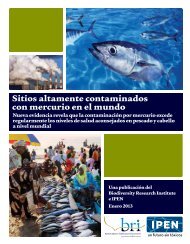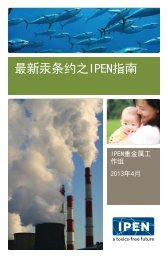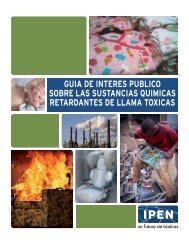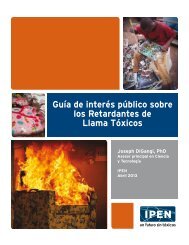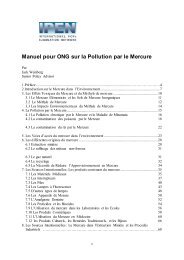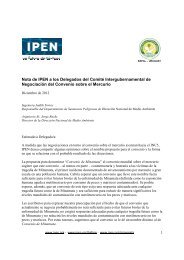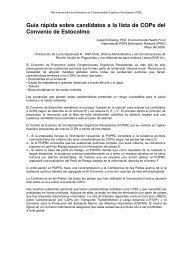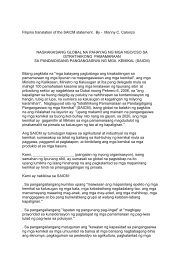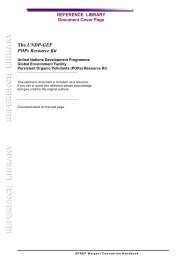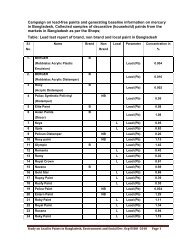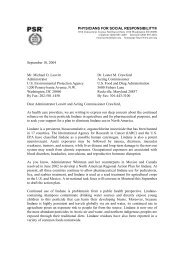A Public Interest Guide to Toxic Flame Retardant Chemicals
A Public Interest Guide to Toxic Flame Retardant Chemicals
A Public Interest Guide to Toxic Flame Retardant Chemicals
You also want an ePaper? Increase the reach of your titles
YUMPU automatically turns print PDFs into web optimized ePapers that Google loves.
erties, such as mutagenicity and carcinogenicity, or adverse effects on the reproductive,<br />
developmental, endocrine, immune, or nervous systems.<br />
5.3 THE TOBACCO INDUSTRY SHIFTED ATTENTION AWAY FROM<br />
CIGARETTES TO FLAME RETARDANT FURNITURE AS THE SOLUTION TO<br />
HOUSE FIRES INSTEAD OF FIRE-SAFE CIGARETTES<br />
In a time of rising numbers of house fires due <strong>to</strong> cigarette smoking, the <strong>to</strong>bacco industry<br />
sought <strong>to</strong> focus blame and a solution away from the actual cause of the fires. As the<br />
Chicago Tribune notes, “…<strong>to</strong>bacco executives didn’t care for one obvious solution: create<br />
a ‘fire-safe’ cigarette, one less likely <strong>to</strong> start a blaze…The industry insisted it could not<br />
make a fire-safe cigarette that would still appeal <strong>to</strong> smokers and instead promoted flame<br />
retardant furniture — shifting attention <strong>to</strong> the couches and chairs that were going up in<br />
flames. But executives realized they lacked credibility, especially when burn victims and<br />
firefighters were pushing for changes <strong>to</strong> cigarettes. So Big Tobacco launched an aggressive<br />
and cunning campaign <strong>to</strong> ‘neutralize’ firefighting organizations and persuade these<br />
far more trusted groups <strong>to</strong> adopt <strong>to</strong>bacco’s cause as their own.” Peter Sparber, a former<br />
<strong>to</strong>bacco industry executive served as the organizer of the US National Association of<br />
State Fire Marshals and the Tribune notes that, “He shaped its requests for federal rules<br />
requiring flame retardant furniture and fed the marshals <strong>to</strong>bacco’s arguments for why<br />
altering furniture was a more effective way <strong>to</strong> prevent fires than altering cigarettes…<br />
The fire marshals’ actions helped Big Tobacco fend off fire-safe requirements for years.”<br />
5.4 THE CHEMICAL INDUSTRY PAID FIRE MARSHALS TO LOBBY ASIAN<br />
ELECTRONICS MANUFACTURERS TO ADD CHEMICALS MARKETED AS<br />
FLAME RETARDANTS TO THEIR PRODUCTS<br />
The Chicago Tribune reports that the chemical industry paid for fire marshals’ lobbying<br />
trips <strong>to</strong> Japan, Korea, and Taiwan <strong>to</strong> convince manufacturers <strong>to</strong> add chemicals <strong>to</strong> plastic<br />
components of computer moni<strong>to</strong>rs and TVs.<br />
5.5 THE CHEMICAL INDUSTRY PAID FIRE MARSHALS TO LOBBY FOR<br />
GLOBAL FIRE STANDARDS ENCOURAGING USE OF CHEMICALS MARKETED<br />
AS FLAME RETARDANTS<br />
As the Chicago Tribune notes, “The marshals later pushed for worldwide standards<br />
requiring that the plastic casings of electronics resist a candle flame and posted Internet<br />
videos comparing name-brand computer moni<strong>to</strong>rs that went up in flames with those<br />
that didn’t.” The industry waged this campaign within the International Electrotechnical<br />
Commission (IEC). IEC is a standards setting body based in Switzerland with a technical<br />
committee (TC108) that focuses on safety standards including fire, electrical, and labeling.<br />
The chemical industry pressured the IEC <strong>to</strong> adopt a candle flame ignition standard in<br />
electronics which would require addition of their chemicals in plastics parts of electronic<br />
equipment. Opponents of the proposal included the US Consumer Product Safety Commission,<br />
US National Fire Protection Association, Consumer Electronics Association, and<br />
the Telecommunications Industry Association. They cited information that concluded<br />
that candle flames were not appropriate or realistic as a standard and that no fire safety<br />
benefit would result from using this standard. Despite strong opposition, the chemical<br />
A PUBLIC INTEREST GUIDE TO TOXIC FLAME RETARDANT CHEMICALS<br />
13



